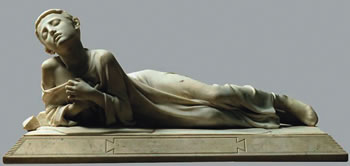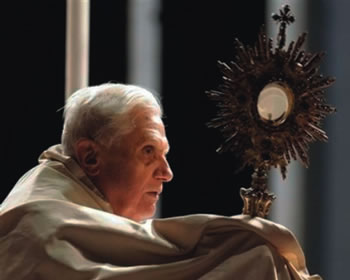St Tarcisius

By Walton Morais
Patron Saint of Altar Servers
The moving account of the life of Saint Tarcisius, a young boy who gave his life to protect the Holy Eucharist, was vividly recounted by Pope Benedict XVI when he addressed a gathering of altar servers in Rome in 2010.
Tarcisius lived in the third century under the cruel reign of Emperor Valerian. Historical documents suggest that the emperor, who ruled from 253-260, relentlessly persecuted Christians including ordering the executions of the bishops of Carthage and Rome.
 Fearful of the emperor's wrath, Christians were forced to share their faith hidden underground in the catacombs.
Fearful of the emperor's wrath, Christians were forced to share their faith hidden underground in the catacombs.
Holy Eucharist had to be delivered secretly, hidden from the Roman guards, at great risk to the bearer.
One day, the priest, as was his custom, asked who was prepared to take the Holy Eucharist to the brothers and sisters. Up stood Tarcisius. ‘Send me,’ he offered.
Little is known of Tarcisius. It is said he was an acolyte, that is, an altar server. The priest was concerned about sending a young boy for such a dangerous task but Tarcisius persisted, saying :’My youth will be the best shield for the Eucharist.’
Touched by his bravery, the priest overcame his own doubts and relented.
"Tarcisius, remember that a heavenly treasure has been entrusted to your weak hands," the priest said.

Saint Tarcisius by Alexandre Falguière
"Avoid crowded streets and remember that holy things must never be thrown to dogs nor pearls to pigs."
He asked the young altar server if he would guard the sacred mysteries faithfully and safely.
"I would die," Tarcisius replied without hesitation, "rather than let go of them."
The little boy's determination was soon to be tested.
Along the way, he was met by some young friends who asked him to join them in their play. Suspicious at his stubborn refusal, the young pagans noticed he was clutching something to his breast as if it were precious treasure.
They jumped on him and brutally attacked him to find out what he was protecting with his life.
Realising he was a Christian, their attacks grew more ferocious. They kicked him, they threw stones at him but he was unbowed.
When he was close to death, a Praetorian guard who had secretly become Christian, intervened.
Quadratus, the guard, carried the dying boy back to the priest.
Sadly, Tarcisius was already dead by the time they arrived. But he was still clutching a small linen bag which contained the Holy Eucharist.
Tarcisius was immediately buried in the catacombs of St Calixtus.
Based on an inscription on his grave ordered by Pope Damasus, Tarcisius died in 257. The date was fixed at August 15 based on Roman martyrology. Roman martyrology is a catalogue of martyrs and saints arranged by their calendar order of their anniversaries or feast days.
The martyrology also has an oral tradition, says Pope Benedict, which claims that the most Blessed Sacrament was never found on St Tarcisius' body - either in his hands or in his clothing.
This, tradition has it, means that the consecrated host, which the little martyr had defended with his life, had become flesh of his flesh, thereby forming, together with his body, a single immaculate host offered to God.
Pope Benedict said the life of St Tarcisius reminds us that love can make us give our lives for an authentic good.

Pope Emeritus Benedict
He said altar servers should prepare themselves inwardly so that every time they approach the altar to help the priest, they can communicate the sacred mystery of the friendship Jesus is offering to us in our everyday lives.
‘Assisting your priest in service at the altar helps to make Jesus closer so that people can understand, can realise better: He is here.’
St Tarcisius, pray for us.
Source: EWTN.com
 Entries(RSS)
Entries(RSS)